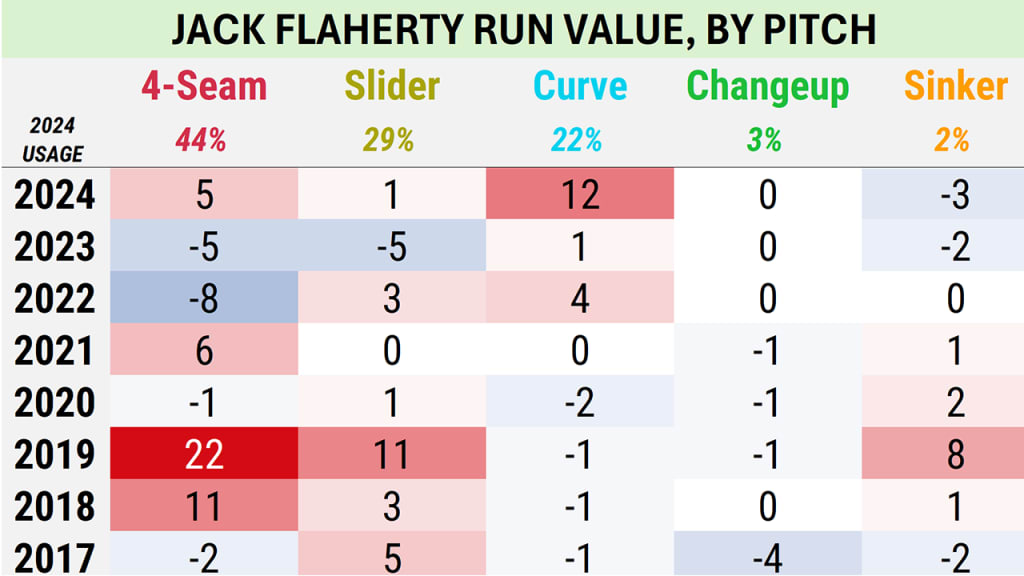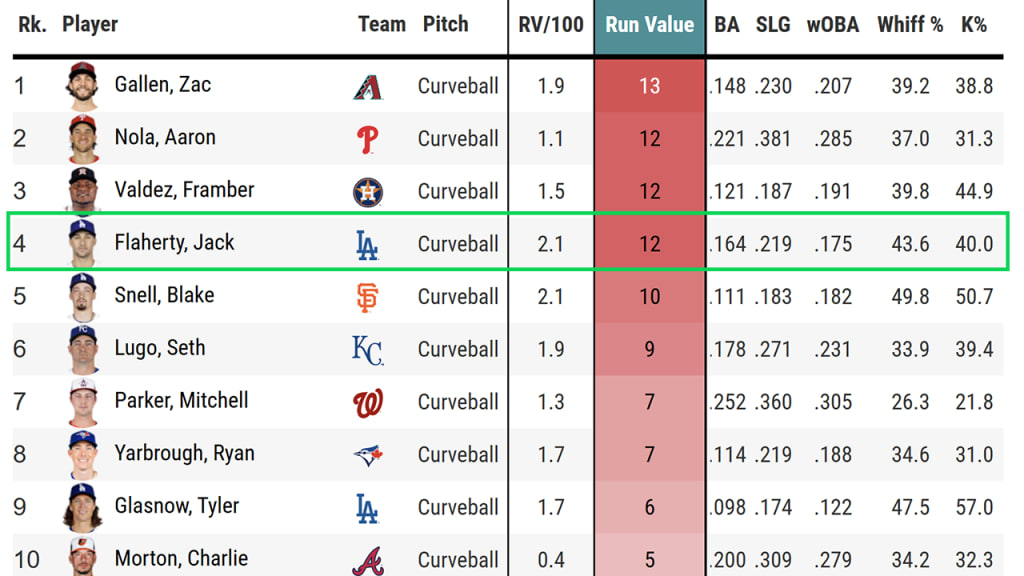If thereˇŻs been a theme of this baseball offseason ˇ well, OK, itˇŻs the Dodgers signing every member of your extended family. But if thereˇŻs another theme, itˇŻs that starting pitchers have been doing quite well in free agency. In a sport desperate for pitching, the starting pitching market got moving fast, and ended up with a number of veteran arms being well-compensated, usually somewhat more than projections would have expected.
Except, that is, for Jack Flaherty, who is the only unsigned member of MLB.comˇŻs pre-Hot Stove Top 10 Free Agent Starters list.
According to FanGraphs, only three starters remain who are projected for even 2 WAR, which is to say average. Since Flaherty is 29 and unencumbered by a Qualifying Offer, as opposed to Nick Pivetta (32, with an Offer) and Max Scherzer (a living legend, but also turning 41 this summer), itˇŻs not a hard case to make that Flaherty is the best free agent starter still available.
You could argue, too, that his hometown Dodgers donˇŻt get to and win the World Series without him, given how paper-thin their rotation was last fall.
And yet: he remains on the market, with little buzz. WhatˇŻs going on ¨C and what might teams hope to get?
What went right in 2024: A healthy rebound
As a 23-year-old in 2019, Flaherty looked like a Cardinals ace-in-the-making, finishing fourth in NL Cy Young voting and putting together a close-to-legendary second half, allowing 10 earned runs in 15 starts (0.91 ERA). It didnˇŻt last. He pitched only 154 2/3 injuries over the next three seasons due to shoulder and oblique injuries, then was healthy but ineffective in 2023, posting a 4.99 ERA between St. Louis and Baltimore.
Signed to a one-year prove-it deal by Detroit last winter, he did exactly that, putting up a 2.95 ERA in 18 starts before being traded to the Dodgers in July. No regular pitcher upped their strikeout rate by as much as he did, and he contributed strong starts as the Los Angeles Game 1 starter in both the NLCS (seven shutout innings) and the World Series (5 1/3 innings of two-run ball).
Given the relative youth, the occasional high points in the track record, the 188 innings he just threw (playoffs included), the label of ˇ°Game 1 starter for the World Series champs,ˇ± and the lack of a Qualifying Offer, itˇŻs not hard to see why you might have expected a somewhat warmer reception for Flaherty in the market this winter; he was, after all, rated as No. 8 on FanGraphs' Top 50 free agents list.
Sounds great, right? Perhaps ¨C but thereˇŻs a flip side, too.
Why it hasnˇŻt happened yet
For all those positive markers, there are some obvious areas for concern.
Flaherty took a step back with the Dodgers: His strikeout rate dropped post-trade (32% to 26%) and his walk rate jumped (5% to 8%). Those two strong postseason starts were countered by three poor ones, culminating in a World Series Game 5 debacle in which he allowed four runs while getting four outs.
While itˇŻs true that heˇŻs been healthy enough to throw a ton of pitches the last two years ¨C Flaherty is in the top 25 of pitches thrown in 2023-24, postseason included ¨C surely no one forgets the reports that the Yankees backed out of a trade due to concerns about his back, which cost him a start in early July. If that sounds like ˇ°inconsistency within a seasonˇ± wrapped into ˇ°inconsistency within a career,ˇ± that would be about right.
ThereˇŻs also the fact that while 13-7, 3.17 seems tremendous, teams arenˇŻt really looking at win-loss record or ERA in the way that they used to; most of the ERA estimators had him more in the 3.60 range (solid, not elite), and early 2025 projections, mindful still of his poor 2023, have him in the 3.80-3.90 range.
ThatˇŻs most of the story, really ¨C ˇ°up-and-down career, up-and-down platform season, some injury issues, and mid-rotation projectionsˇ± ¨C and so itˇŻs not hard to see why, if early reports that he was seeking five years were true, teams would be hesitant to do that. But more recent reports have Flaherty willing to consider shorter deals, and yet heˇŻs still out there. So: what now?
What the metrics say
ItˇŻs 2025. We know teams arenˇŻt just looking at back-of-the-baseball-card stats. So: what are they seeing? A very different Flaherty than the one who was so successful as a young Cardinal, to start.
Remember that all-time great second half of 2019? It was in part tied to velocity. His four-seamer went from 93.8 mph in July to 94.7 in August to 95.1 in September that year, and the outs came along with it. At +22 runs added, it was one of the most valuable pitches in the entire sport that season. ItˇŻs been up-and-down ¨C thereˇŻs that phrase again ¨C in the years since, but was down to 92.6 mph this past September.
If you look at the run value charts by year since his debut, you can really see the changing shape of whatˇŻs worked and what hasnˇŻt. Early on, he had a dominant four-seamer and a strong slider, with a sinker that was sometimes good and sometimes excellent. Now, itˇŻs the curve thatˇŻs his best pitch, with the four-seamer and slider being inconsistent, and the changeup and sinker barely being used at all; he is, essentially, a three-pitch pitcher.

ItˇŻs the fastball thatˇŻs the sticking point here. As FanGraphs recently wrote, the big three free agent starters this winter (Corbin Burnes, Blake Snell, and Max Fried) all have positive outlier fastballs in either velocity, movement, or both. (While not noted, this applies to Sasaki as well.) Flaherty doesnˇŻt, not really, nor the pinpoint execution required to locate it at lower velocities.
As youˇŻd expect, velocity is a huge differentiator here. LetˇŻs split his four-seam velocity at 93.5 mph, which is just about exactly the 50/50 point for him in terms of half being above and half being below. In 2024, the difference in performance is enormous.
- 93.5 and up // .274 wOBA // .343 SLG // 28% whiff
- 93.4 and below // .362 wOBA // .508 SLG // 17% whiff
Which side would you rather be on?
This isnˇŻt unique to him, necessarily, but it does put a lot of pressure on his breaking balls. That's where the good news comes in, though. The slider, at one point, was outstanding, a top-20 slider (+11) back in 2019. The curveball, last year, was outstanding too ¨C it was in the conversation for the most valuable curve in the game. Last year, including the playoffs, Flaherty threw it 687 times and allowed all of nine extra base hits on it.

All of which means, thereˇŻs a lot to work with here, particularly if thereˇŻs a team that thinks it can help restore his slider ¨C which has lost about three inches of induced break from its peak ¨C and promote a breaking-ball heavy agenda if the heater doesnˇŻt come back. (As Ben Clemens wrote in that Top 50 Free Agents piece, his guess was ˇ°that a team that thinks theyˇŻre good at pitch design will sign Flaherty.ˇ±)
Perhaps so, though that describes the Dodgers, and it was more OK than great, without any known interest in a reunion.
In many ways, Flaherty has what every team desires: youth, a recent track record of health, and some high-upside pitches. What he's missing, so far, is consistency. But now he's the best starter left out there, and there are more than a few contending teams that could badly use a youthful mid-rotation starter with, perhaps, some untapped upside remaining.

